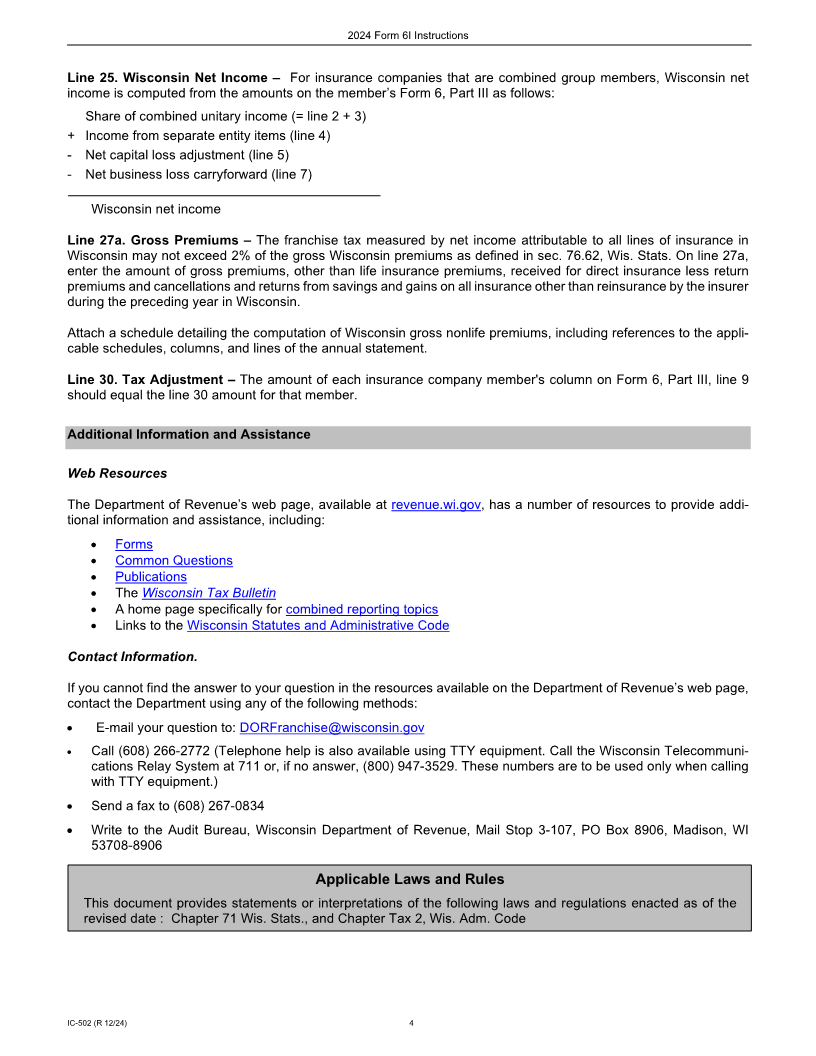
Enlarge image
Instructions for 2024 Form 6I:
Wisconsin Adjustments for Insurance Companies
Purpose of Form 6I
When a corporation computes its Wisconsin franchise or income tax liability, certain aspects of its tax computation
are different if the corporation is an insurance company. Subchapter VII of chapter 71 of the Wisconsin Statutes
provides for these differences.
Whether or not a corporation is an insurance company, it uses Form 6 to compute its Wisconsin franchise or income
tax liability under combined reporting. The purpose of Form 6I is to account for adjustments an insurance company
must make so the amounts on Form 6 reflect the corporation’s status as an insurance company.
Enter the information for each member in a separate column. Enter the elimination adjustments for all members in
the elimination adjustments column as positive and negative values. A positive value will increase the total of the
member's amounts reported in the combined total column and a negative value will decrease the total of the member'
amounts reported in the combined total column. If there are more than three members, use additional Forms 6I,
however, only enter elimination entries and combined totals on the final Form 6I completed. For example, if there
are seven members in the combined group, enter members one through three on Form 6I (do not complete the
elimination and combined total column yet). Next, enter members four through six on an additional Form 6I (do not
complete the elimination and combined total column yet). Finally, complete a new Form 6I for the seventh and final
member. Complete the elimination and combined total column on the last Form 6I for all group members.
Line-by-Line Instructions
These instructions are presented in the order the lines appear on Form 6I:
Part I: Additions Specific to Insurance Companies
This is where the Wisconsin addition modifications unique to insurance companies are computed so they can be
included on Form 6, Part II, line 2i.
Line 1. Loss Carryforward – Enter the insurance company’s loss carryforward, including any capital loss carryfor-
ward previously deducted for Wisconsin. This was the amount deducted in computing the federal taxable income
reported on Form 6, line 1.
Line 2. Dividend Income – Enter the insurance company’s dividend income received during the taxable year to the
extent the dividends were deducted from, or not included in, the federal taxable income reported on Form 6, Part I,
line 4.
Line 3. Deduction for Discounting Unpaid Losses – For tax years beginning before January 1, 2018 enter, any
deduction under section 847 of the Internal Revenue Code that was claimed in computing the federal taxable income
reported for the insurance company on Form 6, Part I, line 28.
Line 4. Total – Include the amount from line 4 in the amount on Form 6, Part II, line 2i.
Part II: Nontaxable Income from Life Insurance Operations
This is where the nontaxable income from life insurance operations is computed. This amount is carried forward to
Form 6, Part II, line 4o.
Line 5. Federal Taxable Income –Enter the amount included in Form 6, Part II, line 1, that is attributable to the
insurance company.
IC-502 (R. 12/24) 1


